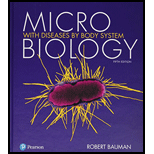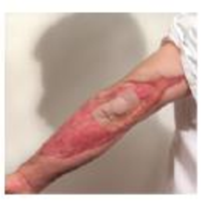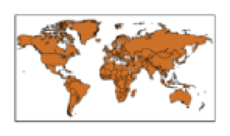
Necrotizing Fasciitis

Fever, chills, nausea, weakness, and general yuckiness. Carlos thought he was getting the flu. Further, he had pulled a cactus thorn from his arm the day before, and the tiny wound had swollen to a centimeter in diameter. It was red, extremely hot, and much more painful than such a puncture had a right to be. Everything was against him. He couldn’t afford to miss days at work, but he had no choice.
He shivered in bed with fever for the next two days and suffered more pain than he had ever experienced, certainly more than the time he broke his leg. Even more than passing a kidney stone. The red, purple, and black inflammation on his arm had grown to the size of a baseball. It was hard to the touch and excruciatingly painful. He decided it was time to call his brother to take him to the doctor. That decision saved his life.
Carlos’s blood pressure dropped severely, and he was unconscious by the time they arrived. The physician immediately admitted Carlos to the hospital, where the medical team raced to treat necrotizing fasciitis, commonly called “flesh-eating” disease. This reemerging disease is caused by group A Streptococcus, a serotype of Gram-positive bacteria also known as Streptococcus pyogenes. Group A strep invades through a break in the skin and travels along the fascia-the protective covering of muscles-producing toxins that destroy human tissues, affecting about 750 people each year in the United States.

By cutting away all the infected tissue; using high-pressure, pure oxygen to inhibit bacterial growth; and applying antimicrobial drugs to kill the bacterium, the doctors stabilized Carlos. After months of skin grafts and rehabilitation, he returned to work, grateful to be alive. (For more about necrotizing fasciitis, see pp.560-561.)
1. What color do cells of S. pyogenes appear after the
Want to see the full answer?
Check out a sample textbook solution
Chapter 4 Solutions
Microbiology with Diseases by Body System (5th Edition)
- Identify the indicated cavity (Fucus). a. antheridia b. conceptacel c. receptacle d. oogonium e. none of thesearrow_forwardIdentify the indicated structure (Saprolegnia). a. antheridium O b. oospore c.sperm d. auxospore e. tetraspore Of. zygosporearrow_forwardUsing information from the primary literature (several references have been provided as a starting point below) please answer the following question: Based on your review of the literature on rewilding, what are the major scientific pros and cons for rewilding? Please note that the focus of this assignment are the (biological) scientific issues associated with rewilding. As will be discussed in class, there are a number of non-scientific issues involved or implicated in rewilding, all ultimately affecting the public acceptability of rewilding. Although these issues are important – indeed, critical – in this assignment you should focus on the biological science issues and questions. Details: You must enumerate at least two pros and at least two cons. Your answer should be no more than 500 well-chosen words, excluding references. Think carefully about how best to organize and structure your answer. Aim for high information density: say a lot, but say it succinctly. Recall Nietzche’s…arrow_forward
- Using information from the primary literature (several references have been provided as a starting point below) please answer the following question: Based on your review of the literature on rewilding, what are the major scientific pros and cons for rewilding? Please note that the focus of this assignment are the (biological) scientific issues associated with rewilding. As will be discussed in class, there are a number of non-scientific issues involved or implicated in rewilding, all ultimately affecting the public acceptability of rewilding. Although these issues are important – indeed, critical – in this assignment you should focus on the biological science issues and questions. Details: You must enumerate at least two pros and at least two cons. Your answer should be no more than 500 well-chosen words, excluding references. Think carefully about how best to organize and structure your answer. Aim for high information density: say a lot, but say it succinctly. Recall Nietzche’s…arrow_forwardNow draw a rough sketch of what the control data might look like if in addition to the specific binding, there was also a considerable amount of nonspecific binding (again using a normal dose/response curve) (do % total bound ligand vs concentration)arrow_forwardWhat are functions of cuboidal cells in the kidney? Select all that apply. Concentration of gases Dilution of chemicals Secretion of molecules Nutrition to tissues Support of tissues Absorption of moleculesarrow_forward
- question1 In plants, epithelial tissue is only found as the outermost cell layer and acts as a barrier. In humans, epithelial tissue is found inside the body as well as on the surface. What function(s) does/do epithelial tissue carry out in humans? Select all that apply. Waste storage Filtration Oxygen transport Protection Diffusion Osmosis Absorptionarrow_forwardWhat words best describes this organism? a. Unicellular/nonmotile Ob. unicellular/motile c. colonial/nonmotile d. colonial/motile e. multicelluar O f. siphonous g. none of thesearrow_forwardIdentify the phylum or class. a. Euglenophyta b. Dinoflagellata c. Bacillariophyceae d. Oomycetes e. Phaeophyceae O f. Myxomycota g. Xanthophyceae ○ h. Chrysophyceae i. Dictyosteliomycota O j. Rhodophyta Ok. Chlorophyceaens I. Charophyceaensarrow_forward
 Medical Terminology for Health Professions, Spira...Health & NutritionISBN:9781305634350Author:Ann Ehrlich, Carol L. Schroeder, Laura Ehrlich, Katrina A. SchroederPublisher:Cengage Learning
Medical Terminology for Health Professions, Spira...Health & NutritionISBN:9781305634350Author:Ann Ehrlich, Carol L. Schroeder, Laura Ehrlich, Katrina A. SchroederPublisher:Cengage Learning- Health Safety And Nutrition F/Young ChildHealth & NutritionISBN:9781305144767Author:MAROTZPublisher:Cengage





